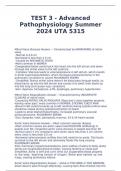TEST 3 - Advanced
Pathophysiology Summer
2024 UTA 5315
Mitral Valve Stenosis Answer - - Characterized by NARROWING of mitral
valve
- Normal is 4-6 cm
-Narrowed is less than 2.5 cm
- Caused by RHEUMATIC FEVER
-More common in WOMEN
-Oxygenated blood comes back into heart into the left atrium and down
through the mitral valve to the left ventricle
- Complex: Stenosis leads to volume/pressure in left atrium, which results
in atrial hypertrophy/dilation, which increases pressure/volume in the
pulmonary circulation & causes PULMONARY EDEMA
- Simplified: Skinny mitral valve doesn't let blood pass through easily, so
blood backs up into the left atrium and causes it to swell, then backs up
into the lung and causes resp. symptoms
-S/sx: dyspnea, hemoptysis, a-fib, dysphagia, pulmonary hypertension
Mitral Valve Regurgitation Answer - -Characterized by INCOMPLETE
CLOSURE of mitral valve
-Caused by MITRAL VALVE PROLAPSE (flaps don't close together properly,
leaving valve ajar); more common in WOMEN; STICKING CHEST PAIN
-Blood in left ventricle backs up to left ventricle during systole (mitral valve
should be closed during systole/contraction of heart)
-Leads to atrial dilation/hypertrophy, increased pulmonary vascular
pressure/volume, PULMONARY EDEMA
-S/sx: Dyspnea, rales, pansystolic murmur, S3 & S4 heart sounds
Aortic Valve Stenosis Answer - -Most common valvular disease
-Most common causes are aortic valve CALCIFICATION (stiffening) in
people over 60; congenital aortic valve stenosis in people less than 30
-Normal valve 3 cm; symptoms seen when valve less than 1 cm; severe
when valve is less than 0.5 cm
-Narrowed valve prevents outflow from left ventricle to aorta. This backs
up blood to the left atrium and ultimately floods the lung causing
PULMONARY EDEMA
S/Sx: Pulmonary hypertension/edema, poor outflow of aorta to body (aorta
sends out oxygenated blood to body), causing fainting or chest pain
Simplified: Aorta is stiff and can't send out oxygenated blood properly
to the body, depriving tissues of oxygen. Blood gets backed up into
lungs, causing pulmonary edema.
Aortic Valve Regurgitation Answer - -Valve is TOO WIDE or TOO NARROW,
blood doesn't pass through effectively, causing back flow of blood into the
,left ventricle
,-Marked by EARLY DIASTOLIC MURMUR (on systole, heart contracts and
pushes blood up the aorta, but on diastole, heart relaxes and ineffective
aortic valve is not able to hold blood up in aorta, so blood falls and makes
a swish sound, which is the murmur)
-Most commonly caused by AORTIC ROOT DILATION(starting point of aorta
is too wide)
-Other causes: infective endocarditis, rheumatic fever, aortitis from
syphilis, coarctation (congenital narrowing of aorta), aortic dissection
(tear), ankylosing spondylitis (inflammatory arthritis)
-Acute: increases left ventricular end-diastolic pressure (LVEDP) (increased
blood back down in the left ventricle increases pressure), decreased stroke
volume (not much blood is being pushed from left ventricle because
blood's backed up and overwhelming left ventricle), normal or decreased
pulse pressure, decreased cardiac output (aorta is not effectively pumping
blood from heart)
Chronic: Body adjusts; LVEDP normalizes, systolic bp increases
(compensation: harder contraction to push blood out of aorta before it
falls back down to left ventricle), diastolic bp decreases (compensation:
decreased relaxation of heart to stop blood from seeping back out of
aorta), cardiac output is normal, pulse pressure is increase. Blood
ultimately is backed up into the left atrium and pulmonary circulation.
Atherosclerosis Causes Answer - -Begins with tissue injury
Sources of injury:
CIGARETTES (toxins)
Hypertension (increased force of the blood hitting the blood vessel can
weaken it) Diabetes
Hyperlipidemia (lipids take place of endothelial cells lining the blood
vessel, initiating an inflammatory response)
Patho of Atherosclerosis r/t Hyperlipidemia - Inflammatory Response
Answer - 1. Tissue injury to endothelial cells lining the blood vessel.
2. Endothelial cells become inflammed and unable to produce
sufficient antithrombotic and vasodilating cytokines, increasing risk
for clot formation and creating a tighter space for plaques and clots
to grow.
3. Macrophages and platelets are called to the area of injury, further
congesting the growing plaque area.
4. LDL replaces endothelial cells in the lining of the blood vessel.
5. Macrophages engulf the LDL particles.
6. Macrophages eat too much LDL, causing them to burst and become
foam cells (under a microscope they look like sea foam)
7.Accumulation of foam cells causes a fatty streak. Fatting streak
further triggers inflammatory responses, repeating the whole cycle,
and growing the fatty streak.
8. Smooth muscle hyperplasia from all the inflammation grows,
produces collagen, and covers the fatty streak to create a fibrous
plaque.
9. The plaque may calcify, protrude into the vessel, and occlude blood
flow, resulting in ischemia or infarction.
, Hyperlipidemia Answer - Leading cause of coronary artery disease




